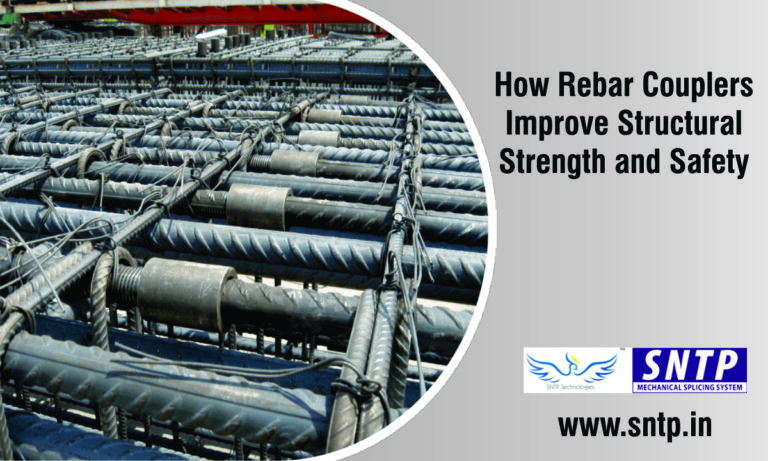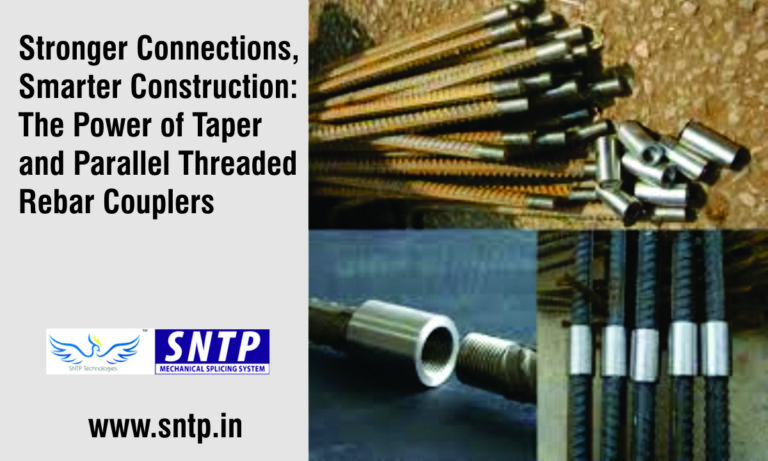+91 9953 65 9594

How Rebar Couplers Improve Structural Strength and Safety
In the construction industry, structural integrity and safety are two pillars that define the longevity and reliability of any project. As buildings grow taller and infrastructure becomes more complex, engineers constantly seek better ways to connect reinforcement bars without compromising strength. This is where Rebar couplers have emerged as a modern solution, replacing traditional lapping methods with superior precision, durability, and performance.
SNTP Technologies®, India’s first company to receive BIS certification for rebar couplers, has been at the forefront of this innovation—helping redefine how the country builds safer and stronger structures.
Understanding Rebar Couplers
A rebar coupler is a mechanical connector used to join two steel reinforcement bars (rebars) end-to-end. Unlike traditional lapping, which overlaps steel bars to create continuity, couplers provide a direct load transfer mechanism, ensuring uniform stress distribution across the connection.
These couplers are engineered with high-tensile steel and precise threading, allowing them to handle immense loads while maintaining alignment and integrity. The result is a stronger, more compact joint that enhances both structural strength and safety.
The Limitations of Traditional Lapping
To understand the true value of rebar couplers, it’s essential to recognize the drawbacks of the traditional lapping process:
- Material Waste: Lapping requires overlapping rebars, which increases steel consumption.
- Inconsistent Strength: Overlaps create uneven load distribution and weak zones.
- Space Constraints: In congested reinforcement areas, overlaps cause congestion, making concrete compaction difficult.
- Limited Durability: Improper lapping can lead to cracks, corrosion, or joint failures over time.
In contrast, rebar couplers eliminate these issues entirely by ensuring mechanical continuity instead of relying on friction or overlap.
1. Enhanced Load Transfer and Structural Strength
The primary function of a rebar coupler is to transfer loads efficiently between connected rebars. Unlike lapping, which relies on concrete bonding, couplers use mechanical interlocking to create a seamless load path.
This mechanical connection ensures that:
- The load is evenly distributed across both rebars.
- Stress concentrations at joints are minimized.
- The structure’s overall tensile and compressive strength is improved.
As a result, structures using rebar couplers can withstand higher loads and perform better under extreme conditions such as earthquakes, wind, and vibrations.
2. Improved Safety in Structural Design
Safety is paramount in construction, especially in high-rise buildings, bridges, tunnels, and metro systems. Rebar couplers significantly enhance structural safety by:
- Eliminating Weak Zones: Mechanical joints ensure full strength continuity across the connection.
- Reducing Human Error: Prefabricated couplers simplify installation and reduce dependency on manual alignment.
- Increasing Earthquake Resistance: The flexibility and high load-bearing capacity of couplers make structures more resistant to seismic forces.
- Ensuring Consistent Quality: Factory-manufactured couplers from certified producers like SNTP Technologies maintain strict quality standards, reducing on-site variability.
These advantages translate into stronger, safer, and more durable infrastructure that performs reliably even under critical loads.
3. Durability and Corrosion Resistance
Durability is a key factor influencing a structure’s lifespan. Rebar couplers contribute significantly by minimizing corrosion risks and enhancing material performance.
How couplers improve durability:
- Reduced Steel Overlap: Less steel usage means fewer exposed joints prone to corrosion.
- Protective Coatings: High-quality couplers are coated with anti-rust materials, offering long-term resistance to environmental degradation.
- Improved Concrete Compaction: Without overlapping bars, concrete flows and compacts more evenly, reducing voids and protecting rebars from moisture intrusion.
SNTP Technologies ensures that every coupler meets ISO 9001:2015 and BIS quality standards—ensuring maximum protection against corrosion and long-term structural reliability.
4. Precision and Standardization
Traditional rebar lapping often suffers from inconsistencies due to manual errors during installation. Rebar couplers, however, offer uniformity and precision through machine-based production and standardization.
- Dimensional Accuracy: Every coupler is engineered to match specific rebar diameters.
- Quality Control: Automated threading and torque testing guarantee consistent performance.
- Standardized Installation: The use of couplers ensures repeatable and predictable joint strength across all reinforcement connections.
This level of precision not only enhances strength but also simplifies inspection and quality assurance for large-scale construction projects.
5. Space Efficiency and Design Flexibility
As modern structures demand more complex designs, space within reinforced sections often becomes limited. Rebar couplers solve this challenge by eliminating overlapping bars, freeing up valuable space and improving concrete flow.
Key benefits include:
- Reduced Congestion: Easier placement of rebars and better concrete consolidation.
- Compact Joints: Ideal for columns, beams, and heavily reinforced zones.
- Architectural Flexibility: Enables innovative designs without compromising safety.
By allowing engineers to design slimmer, lighter, and more efficient structures, couplers open new possibilities in architectural and structural design.
6. Sustainability and Material Efficiency
Sustainability is now a key objective in modern construction, and rebar couplers contribute directly to greener practices.
- Reduced Steel Usage: Eliminating lap lengths saves up to 30% steel in some projects.
- Lower Carbon Footprint: Less steel consumption translates into reduced energy use and emissions.
- Longer Lifespan: Durable joints require fewer repairs and replacements, minimizing waste over time.
By adopting SNTP Technologies’ rebar couplers, builders not only achieve superior strength but also support environmentally responsible construction practices.
7. Compliance with International Standards
SNTP Technologies’ rebar couplers are BIS-certified, representing a first-of-its-kind milestone in India’s reinforcement industry. This certification validates compliance with national and international quality benchmarks, including:
- Bureau of Indian Standards (BIS)
- ISO 9001:2015
- Global Engineering Norms for Reinforcement Systems
Compliance ensures that each coupler delivers consistent mechanical performance, safety assurance, and long-term reliability—qualities essential for India’s rapidly growing infrastructure.
Conclusion
The evolution from traditional rebar lapping to mechanical rebar couplers marks a transformative step in modern construction. These innovative connectors not only improve structural strength by enabling efficient load transfer and uniform stress distribution but also enhance safety, durability, and sustainability across all types of projects.
With advanced manufacturing technology, strict quality control, and the distinction of being India’s first BIS-certified company for rebar couplers, SNTP Technologies continues to set new benchmarks in reinforcement technology.
By choosing SNTP’s rebar couplers, engineers and builders invest in more than just a product—they invest in precision, safety, and a stronger future for India’s infrastructure.
© Copyright 2017.SNTP All Rights Reserved.
Design & Developed By Star Web Maker







